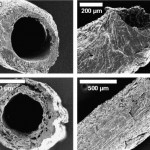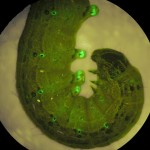Insects have accompanied humanity through thousands of years, but it is in the last decades that insects have been utilized biotechnologically or industrial applications.

Silk fibroin microtubes for blood vessel engineering
In addition to the well known textile application of the silk, researches from all over the world are studying the application of this material to biotechnology. Thanks to this approach, it has been discovered that fabric is adequate substrate for the growth of mother cells, and it can be used in regeneration therapy of bone and ocular tissue. Silk also has proteins which can be used for the controlled release of pharmaceuticals, and has multiple applications to cosmetic industries.
The intensive study of the insects´ exoskeleton has allowed the development of new technologies based in bio-materials. Copying the cuticle of some species, EU researchers have created a material similar to plastic, resistant and light like aluminum but more economical. Other studies reveal that the natural composition and distribution of the some beetles scales, imitated in the lab, are able to keep and control the light allowing development of new materials.

Recombinant baculovirus infection
The larva of certain lepidopteron species are used in bio-factories for the production of recombinant proteins, using recombinant baculovirus as vectors. One Japanese company produces interferon to be used with pets. Their product is actually commercialized in Europe. To produce the interferon, the company use Bombix mory larva. Like them, other companies are working to produce vaccines or rare diseases treatments using the same technology with different lepidopteron species in developing countries.
Trying to solve a human nutritional problem in Benin, the priest Godfrey Nzmujo used urban residues to fed fly larva. Afterwards, the larvae were harvested and used as poultry and fish feed. Using this saprophytic insect, the priest solved the problems with residues, mitigated malnutrition and helped to develop an antibiotic out of the larva saliva.
In Congo, they use Hermetia illuscens larva to bio-process oil palm residues from the early century. The collected larvae are used in aquaculture to feed diverse species of fish, eliminating the agricultural residue and decreasing human starvation in the area. Similar, in the US, it is also being used for a while the same specie to reduce pig manure, protein production, humus and other byproducts of interest.

Predator for biological control
In the South-East Spain the pesticide have been steadily been reduced in agriculture, thanks to the used of insects and mites for the biological pest control of pest on the crops. Due to that the region has became in an international reference, giving quality and security to the food. The trend has produced great developments in the mass rearing of insects and mites for biological pest control propose.
Admiring the multiple applications of insects in the technology, we can only think that there is so much to be done and to be researched. From Entomotech, we have decided that we would like to be an active part of the development of new technologies which are respectful to the environment, to advance the industry, and diversifying the productive systems. It is because of this, we put all our knowledge, pushing energy and illusion to collaborate with any company, research group or entity, for the development of innovative tools, and for looking for new solutions to the present and future productive challenges.


